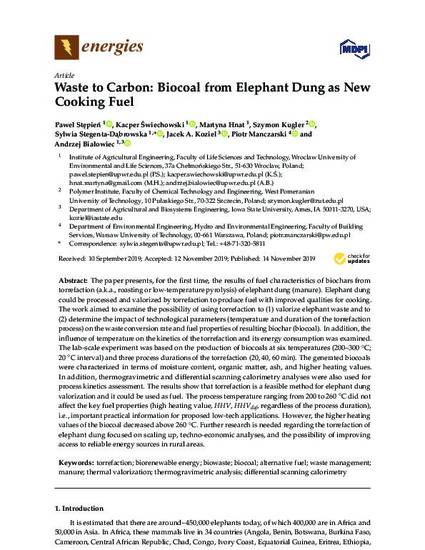
The paper presents, for the first time, the results of fuel characteristics of biochars from torrefaction (a.k.a., roasting or low-temperature pyrolysis) of elephant dung (manure). Elephant dung could be processed and valorized by torrefaction to produce fuel with improved qualities for cooking. The work aimed to examine the possibility of using torrefaction to (1) valorize elephant waste and to (2) determine the impact of technological parameters (temperature and duration of the torrefaction process) on the waste conversion rate and fuel properties of resulting biochar (biocoal). In addition, the influence of temperature on the kinetics of the torrefaction and its energy consumption was examined. The lab-scale experiment was based on the production of biocoals at six temperatures (200–300 °C; 20 °C interval) and three process durations of the torrefaction (20, 40, 60 min). The generated biocoals were characterized in terms of moisture content, organic matter, ash, and higher heating values. In addition, thermogravimetric and differential scanning calorimetry analyses were also used for process kinetics assessment. The results show that torrefaction is a feasible method for elephant dung valorization and it could be used as fuel. The process temperature ranging from 200 to 260 °C did not affect the key fuel properties (high heating value, HHV, HHVdaf, regardless of the process duration), i.e., important practical information for proposed low-tech applications. However, the higher heating values of the biocoal decreased above 260 °C. Further research is needed regarding the torrefaction of elephant dung focused on scaling up, techno-economic analyses, and the possibility of improving access to reliable energy sources in rural areas
Available at: http://works.bepress.com/jacek_koziel/435/

This article is published as Stępień, Paweł, Kacper Świechowski, Martyna Hnat, Szymon Kugler, Sylwia Stegenta-Dąbrowska, Jacek A. Koziel, Piotr Manczarski, and Andrzej Białowiec. "Waste to carbon: Biocoal from elephant dung as new cooking fuel." Energies 12, no. 22 (2019): 4344. DOI: 10.3390/en12224344. Posted with permission.